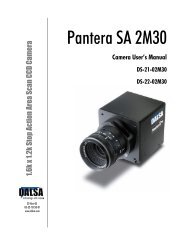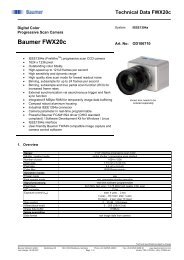TR-33 TR-34 TR-35 Trillium Rhino User's Manual - Frame Grabbers
TR-33 TR-34 TR-35 Trillium Rhino User's Manual - Frame Grabbers
TR-33 TR-34 TR-35 Trillium Rhino User's Manual - Frame Grabbers
Create successful ePaper yourself
Turn your PDF publications into a flip-book with our unique Google optimized e-Paper software.
64 <strong>Trillium</strong> User’s <strong>Manual</strong><br />
The initial object for the camera should be white plastic or PVC with minimal<br />
texture or grain. Paper is undesirable as the grain induces significant PRNU after<br />
calibration. To assess your illumination requirements:<br />
Note: Running<br />
the camera from<br />
an internally<br />
generated sync<br />
signal allows for<br />
the greatest<br />
flexibility while<br />
performing the<br />
procedure.<br />
1. Set the sync source to internal with exposure control off by sending the<br />
command set_sync_mode 2.<br />
2. Set the maximum desired line rate by sending the command<br />
set_sync_frequency frequency, where frequency is the line rate in<br />
kHz.<br />
3. Set the gain for each channel to the lowest level by sending the command<br />
set_gain 1,1,1.<br />
4. Determine the response of each channel by sending the command<br />
get_line_statistics #channel, 20. For example,<br />
get_line_statisticc 3, 20. Where 20 is the number of lines used to<br />
determine the statistics. Record the average response for each channel and<br />
calculate the gain required to achieve approximately 200 DN.<br />
5. Using the gain values determined above, send the set_gain command<br />
again. (Note: 15.98 is the maximum.)<br />
6. Determine the response of each channel by sending the command<br />
get_line_statistics #channel, 20. The average values reported<br />
should be close to 200 DN. If not, adjust the gains appropriately.<br />
You have now established the approximate gains the camera will use when<br />
calibrated. The higher the gains, the worse the generated noise level.<br />
Determining Noise Levels<br />
To determine the noise level generated by the camera at the established gain<br />
settings, use the command get_line_noise #channel, 20.<br />
The values returned are for RMS noise. Peak to peak noise will be about 5 times<br />
this figure. Any extraneous light, particularly from fluorescent fixtures, can affect<br />
the noise figure significantly, especially when the gains are high. Try turning<br />
lights off in the vicinity of the camera to determine if the noise figures change.<br />
Note that the get_line_noise command returns slightly higher figures than<br />
actually exist on the data port. This is due to a different noise environment<br />
existing within the camera while the embedded controller is capturing data.<br />
03-32-10119-03 DALSA
















